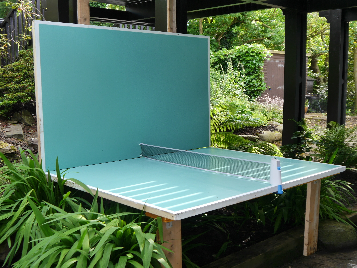TABLE SQUASH
 Table squash is a simple and obvious derivative of table tennis that has undoubtedly been invented many times. Although the name does not really describe the game adequately, it is hard to find a suitable alternative. The version detailed here was developed in Glasgow and played by Glasgow University students in the late 1970s. Subsequently the game has been developed in Leeds (Wikipedia 2009).
Table squash is a simple and obvious derivative of table tennis that has undoubtedly been invented many times. Although the name does not really describe the game adequately, it is hard to find a suitable alternative. The version detailed here was developed in Glasgow and played by Glasgow University students in the late 1970s. Subsequently the game has been developed in Leeds (Wikipedia 2009).
Originally it used half a table-
One sensor in the wall board was able to count the rallies to include them in the score, and a sensor in each side of the table could to identify the contribution of each player and monitor scoring of the whole match.
Red and Green
The players could now be identified by red/green LEDs one each side of the table court, changing sides according to the rules of table tennis, in which the games won and the rallies accumulated by the winner of each game could both contribute to the match score. A new name was required to distinguish this from Table Squash.
TABLE SCOTCH
Spin plays a major role in table tennis, but in table squash/scotch it is even more important because the ball bounces twice in each half-
Scoring
The possibility of including the rally count in scoring opens a number of new programmable game strategies and score targets. Purists might be scandalised by the fact that most such strategies will reduce the tyranny of the low ‘killer’ serve, while ignoring the pleasures of exploring the height dimension.
Display
For the development of table scotch we have used a simple alphanumeric LCD device, mounted in front of the net, where it is visible to both players.
Currently it displays the scoring mode:-
Win by Games
Win by Rallies
Win by Games of Rallies
Win by Games and Rallies
The game target (e. 6,11,16,21)
The Rally target ( eg 29,47,79) fancifully based on the atomic numbers of the noble metals
The height of the impact on the Wall board to be used as a possible bonus.
Solo Play
This is displayed on the blue LED segment, which switches from left to right every five games. Quite a lot of practise is required for players to be equally comfortable serving from right or left, especially if they show a preference for either forehand or backhand. Here the player can identify as:-
SID/LILY serving from the left and DEC/RITA serving from the right.